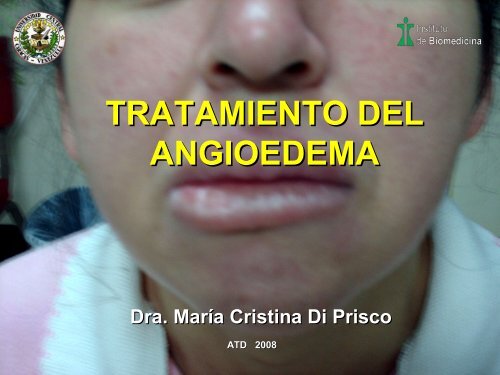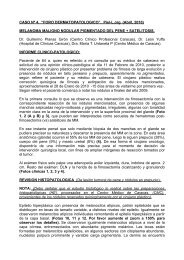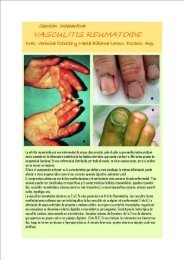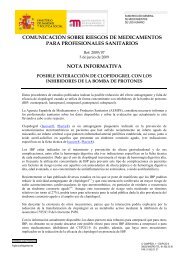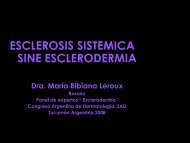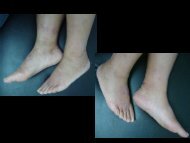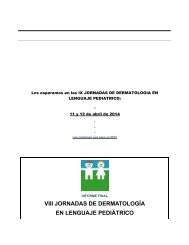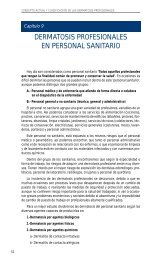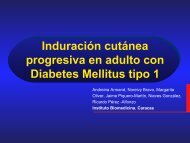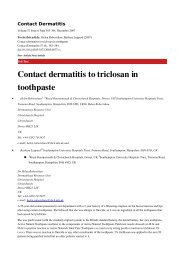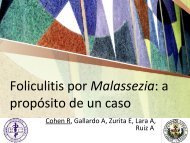tratamiento-del-angioedema-atd-2008-pdf - PIEL-L Latinoamericana
tratamiento-del-angioedema-atd-2008-pdf - PIEL-L Latinoamericana
tratamiento-del-angioedema-atd-2008-pdf - PIEL-L Latinoamericana
You also want an ePaper? Increase the reach of your titles
YUMPU automatically turns print PDFs into web optimized ePapers that Google loves.
TRATAMIENTO DEL<br />
ANGIOEDEMA<br />
Dra. María Cristina Di Prisco<br />
ATD <strong>2008</strong>
ANGIOEDEMA<br />
Es un edema localizado y autolimitado de la piel, tejido celular<br />
subcutáneo y membranas mucosas.<br />
Ocurre en aproximadamente 15% de la población general (Temiño y<br />
Peebles <strong>2008</strong>)<br />
Localización: : cara, lengua, labios y cuello. Puede presentarse también<br />
en miembros superiores e inferiores, principalmente en manos y pies.<br />
Tracto gastrointestinal y tracto respiratorio ,puede causar obstrucción<br />
de las vías aéreas con edema de laringe (25 a 45%) y muerte.<br />
Es un edema duro,<br />
no deja fóvea y<br />
puede durar dsde<br />
24 horas hasta 36<br />
horas dependiendo<br />
de su origen o<br />
etiología, 50% <strong>del</strong><br />
AE cursa con<br />
urticaria.
CLASIFICACION DEL ANGIOEDEMA<br />
I.- Angioedema Idiopático Recurrente<br />
II.- Angioedema Alérgico (IgE). Puede identificarse el<br />
agente etiológico<br />
III.- Angioedema hereditario con herencia autosómica<br />
dominante<br />
Tipo 1 bajos niveles séricos C1 INH (85%)<br />
Tipo 2 C1 INH disfuncional (15%)<br />
Tipo 3 mutación <strong>del</strong> gen <strong>del</strong> FXII*<br />
*Estrógeno dependiente, asociado con uso de anticonceptivos o terapia sustitutiva
CLASIFICACION DEL ANGIOEDEMA<br />
IV.- Angioedema Adquirido (autoinmunidad)<br />
Tipo 1 deficiencia de C1 INH (enfermedades<br />
linfoproliferativas)<br />
Tipo 2 autoanticuerpo anti-C1 INH<br />
V.- Inhibidores de la Enzima Convertidora de<br />
Angiotensina (ECA) aumentan de niveles de<br />
bradiquinina.
CLASIFICACION DEL ANGIOEDEMA<br />
VI.- Otras causas:<br />
a) Físicas (frío, calor, vibración, trauma,<br />
stress, luz UV)<br />
b) Asociado a citoquinas (GMCSF, IL3, IL 5,<br />
IL 6, T CD4+) con eosinofilia (Síndrome de<br />
Gleich)
Causas más comunes de <strong>angioedema</strong> moderado o<br />
severo en pacientes hospitalizados<br />
80 –<br />
70 –<br />
60 –<br />
%<br />
50 –<br />
40 –<br />
30 –<br />
20 –<br />
10 –<br />
0 –<br />
IECA ASA/AINES Degranuladores directos de<br />
mastocitos<br />
Antibióticos<br />
Banerji et al., Allergy Asthma Proc 29:88-92, <strong>2008</strong><br />
60/64 pacientes (93%) fué atribuido a medicamentos.<br />
5/64 pacientes (7%) otras causas: 1 AEH, 3 AEI con o sin<br />
urticaria, 1 AE secundario a <strong>tratamiento</strong> hormonal<br />
La causa mas frecuente combinación de medicamentos.<br />
IECA 56%, ASA/AINES 70%, opiáceos 36%
DIAGNOSTICO DEL ANGIOEDEMA<br />
Historia Clínica (identificar inductores, familiares)<br />
AE Alérgico tryptasa sérica, RAST<br />
AE Hereditario marcadores séricos de<br />
complemento, niveles séricos de C1 IHN (Tipo 1<br />
bajo, Tipo 2 normal o alto)<br />
AE Adquirido investigar malignidad y niveles<br />
séricos <strong>del</strong> auto anticuerpo anti-C1 INH
Caracterización Clínica <strong>del</strong> Angioedema<br />
AEH<br />
AEA<br />
AEI<br />
Angioedema<br />
Urticaria<br />
Edad de Comienzo<br />
Historia familiar<br />
Enfermedad asociada<br />
Localización <strong>del</strong> edema<br />
Inducido por trauma<br />
Duración (horas)<br />
Respuesta al <strong>tratamiento</strong>: adrenalina,<br />
antihistamínicos, corticosteroides<br />
SI<br />
NO<br />
6-20 años<br />
SI<br />
NO<br />
Todas<br />
SI<br />
48-72<br />
NO<br />
SI<br />
NO<br />
> 50 años<br />
NO<br />
SI<br />
Todas<br />
SI<br />
48-72<br />
No<br />
SI<br />
SI<br />
Cualquier<br />
NO<br />
NO<br />
Cara<br />
NO<br />
2-48<br />
SI
Caracterización <strong>del</strong> Laboratorio para<br />
Angioedema Hereditario<br />
AEH<br />
AEA<br />
AEI<br />
Nivel funcional <strong>del</strong> C1 INH<br />
Bajo<br />
Bajo<br />
Normal<br />
Nivel antigénico <strong>del</strong> C1 INH<br />
Bajo (85%)<br />
Normal (15%)<br />
Bajo<br />
Normal<br />
Nivel C4<br />
Bajo<br />
Bajo<br />
Normal<br />
Nivel C1q<br />
Normal<br />
Bajo<br />
Normal
Consider C1 inhibidor deficiency:<br />
● Recurrent <strong>angioedema</strong> (without urticaria)<br />
● Recurrent episodes of abdominal pain and vomiting<br />
● Leryngeal edema<br />
● Positive family for <strong>angioedema</strong><br />
Meausre: serum complement factor 4 (C4),<br />
C1 inhibitor antigenic protein (C1 Inh), C1q<br />
ALGORITMO<br />
DIAGNOSTICO DE<br />
ANGIOEDEMA<br />
C4, C1 Inh C1q<br />
Quantities normal<br />
C4 quantity low but<br />
C1 Inh protein normal or<br />
elevated; C1q normal<br />
C4 and C1 Inh protein<br />
quantities decreased,<br />
C1q normal<br />
C4 and C1 low<br />
C1 Inh protein normal<br />
Or low<br />
Determine C1 inhibitor<br />
Function in plasma<br />
Repeat C4 measurement<br />
During an acute attack<br />
Determine C1<br />
inhibitor function<br />
Diagnosis:<br />
Hereditary<br />
<strong>angioedema</strong> type I<br />
Confirm by second measurement<br />
of C4 and C1 Inhibitor quantity<br />
and function<br />
Determine C1<br />
inhibitor function<br />
All measurements are normal,<br />
even during<br />
acute attacks<br />
C1 inhibitor function<br />
decreased<br />
C1 inhibitor function<br />
normal<br />
C1 inhibitor function<br />
decreased<br />
Consider <strong>angioedema</strong> types<br />
other than HAE types I and II<br />
- Medication e.g ACE inhibitors<br />
- Estrogen-related<br />
- Other<br />
Diagnosis:<br />
Hereditary<br />
<strong>angioedema</strong> type II<br />
Confirm by second<br />
measurement of C4 and C1<br />
Inhibitor quantity<br />
and function<br />
Other disease<br />
e.g. autoinmune<<br />
Temiño y Peebles <strong>2008</strong><br />
Diagnosis:<br />
Acquired<br />
<strong>angioedema</strong><br />
Determine anti-C1<br />
Inhibitor<br />
antibody
FISIOPATOLOGIA<br />
DEL ANGIOEDEMA<br />
HEREDITARIO<br />
COMPLEMENTO<br />
C1 INH regula la<br />
interacción<br />
entre<br />
(inhibe) las vías<br />
fibrinolíticas y de<br />
coagulación y la<br />
activación<br />
<strong>del</strong><br />
sistema<br />
<strong>del</strong><br />
complemento<br />
(Davies<br />
A.E. <strong>2008</strong>)<br />
Wikimedia Commons<br />
Wikimedia Commons<br />
modified on 24 May <strong>2008</strong>
FISIOPATOLOGIA DEL ANGIOEDEMA HEREDITARIO<br />
El principal mediador de AE es bradiquinina<br />
Sistema Fibrinolitico<br />
Generación de bradiquinina:<br />
(Davies A.E. <strong>2008</strong>)<br />
KalliKreina <strong>del</strong> plasma activada y Factor Hageman (XIIa) cliva el kininógeno de alto peso molecular<br />
liberando bradiquinina.<br />
Bradiquinina potente péptido inflamatorio que causa aumento de la permeabilidad vascular entre otros<br />
efectos.
TRATAMIENTO DEL ANGIOEDEMA<br />
EMERGENCIA (todos los tipos) Intubación si hay compromiso<br />
de las vás aereas.<br />
AE ALERGICO<br />
a) Evitar alergenos<br />
b) Antihistamínicos y corticosteroides<br />
c) Epinefrina IM o EndoTraqueal<br />
AE ADQUIRIDO a) concentrado de C1 INH o plasma fresco<br />
b) <strong>tratamiento</strong> de la enfermedad de base.
TRATAMIENTO DEL ANGIOEDEMA<br />
AE Inducido por el inhibidor de ECA<br />
omitir medicamento<br />
AE Recurrente Idiopático<br />
a) Corticosteroides evaluar cada 3 meses<br />
b) Antagonista <strong>del</strong> receptor de bradiquinina (icatibant)<br />
protocolos Fase 2<br />
c) Inhibidor de la kallikrein <strong>del</strong> plasma (DX 88)<br />
protocolos Fase 3<br />
Temiño y Peebles <strong>2008</strong><br />
Zuraw B.L. <strong>2008</strong><br />
Frank M.M. <strong>2008</strong>
TRATAMIENTO DEL AEH<br />
a)Evitar inhibidores ECA y estrógenos<br />
b)Episodios agudos y profilaxis a corto plazo antes de<br />
<strong>tratamiento</strong> odontológico o cirugía, concentrados <strong>del</strong> C1<br />
INH o plasma fresco 10 ml/Kg, 2 unidades (400ml para<br />
un adulto) (Europa y Canadá)<br />
c)Profilaxis a largo plazo<br />
andrógenos anabolizantes<br />
(Danazol 2,5-10 mg/Kg/d máxima600mg/d, stanozolol,<br />
oxandrolone,). Acido tranexámico30-50mg/Kg/d y ácido<br />
epsilon aminocaproico
Protocolos Clínicos de Terapias Emergentes<br />
para el <strong>tratamiento</strong> de AEH<br />
C1 INH purificado (Lev. Pharmaceutical NY) y (CSL<br />
Behring, King of Prussia Penn.)<br />
C1 INH recombinante<br />
Netherlands)<br />
(Pharming, Leiden The<br />
Dx 88 (Ecallantide) Fase 3 Inhibidor de Kallikrein<br />
(Dyax, Cambridge, Mass)<br />
Antagonistas <strong>del</strong> BR2 (Jerini, Berlin, Germany)
FISIOPATOLOGIA EAH<br />
BRADIQUININA MEDIADOR PRIMARIO EN AEH<br />
Obtención de proteína con actividad de kinina de<br />
plasma de AEH<br />
Esta actividad fue suceptible a inactivación por<br />
kininasa<br />
Drogas que actúan sobre las vías de generación de<br />
bradiquinina son efectivas en el <strong>tratamiento</strong> de AEH<br />
Davies A.E. <strong>2008</strong>


